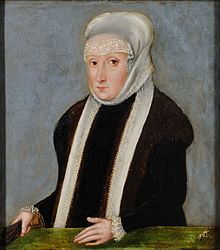Isabella Jagiellon
| Isabella Jagiellon | |
|---|---|

Portrait of Isabella by Lucas Cranach the Younger (around 1565)
|
|
| Queen consort of Hungary | |
| Tenure | 1539–1540 |
| Coronation | 23 February 1539 Székesfehérvár, Hungary |
| Born |
18 January 1519 Kraków, Poland |
| Died | 15 September 1559 (aged 40) Alba Iulia, Transylvania |
| Burial | St. Michael's Cathedral, Alba Iulia |
| Spouse | John Zápolya |
| Issue | John Sigismund Zápolya |
| Dynasty | Jagiellon |
| Father | Sigismund I the Old |
| Mother | Bona Sforza |
| Religion | Roman Catholic |
Isabella Jagiellon (Hungarian: Izabella királyné; Polish: Izabela Jagiellonka; 18 January 1519 – 15 September 1559) was the oldest child of Polish King Sigismund I the Old and his Italian wife Bona Sforza. In 1539, she married John Zápolya, Voivode of Transylvania and King of Hungary, becoming Queen consort of Hungary. At the time Hungary was contested between Archduke Ferdinand of Austria who wanted to add it to the Habsburg domains (see Royal Hungary), local nobles who wanted to keep Hungary independent (see Eastern Hungarian Kingdom), and Sultan Suleiman the Magnificent who saw it as a vassal state of the Ottoman Empire (see also Little War in Hungary). While Isabella's marriage lasted only a year and a half, it did produce a male heir – John Sigismund Zápolya born just two weeks before his father's death in July 1540. She spent the rest of her life embroiled in succession disputes on behalf of her son. Her husband's death sparked renewed hostilities but Sultan Suleiman established her as a regent of Transylvania on behalf of her infant son. The region developed as a semi-independent buffer state noted for its freedom of religion. Ferdinand, however, never renounced his claims and conspired with Bishop George Martinuzzi who forced Isabella to abdicate in 1551. She returned to her native Poland to live with her family. Sultan Suleiman retaliated and threatened to invade Hungary in 1555–56 forcing nobles to invite Isabella back to Transylvania. She returned in October 1556 and ruled as her son's regent until her death in September 1559.
...
Wikipedia
